NationalEclipse.com | Dec 6, 2016 | National Eclipse Blog
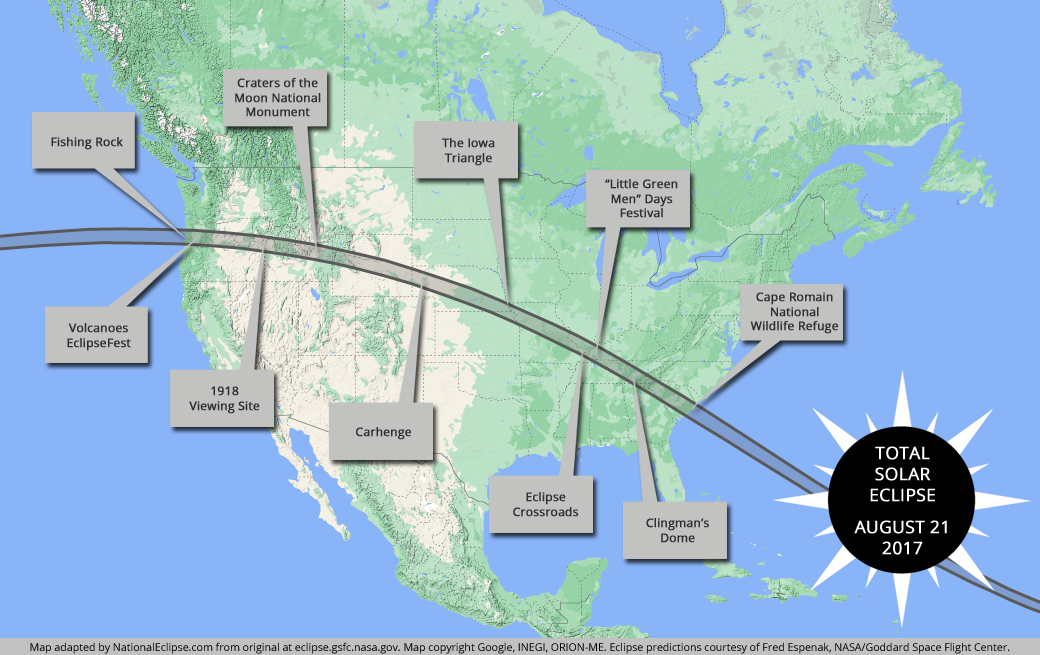
With less than a year to go until the 2017 eclipse touches down in the U.S., the obligatory top ten lists of the "best" or "greatest" viewing sites are starting to pop up in the media and around the web. Usually, these lists focus on places with the most promising weather prospects, the longest durations of totality, or the most interesting local attractions. To be sure, these lists are valuable if you're still trying to decide where to go to see the eclipse. But for our list, we decided to resist the temptation to mimic what everyone else is doing and instead add some levity to the decisionmaking process by offering our picks for the most quirky, outrageous, or just plain unique places to view the 2017 eclipse. On August 21, 2017, everyone should seek out clear skies and long durations, but if you want a good story too, this list is for you. Here are our picks, presented from west to east along the path of totality:
1. Fishing Rock — Lincoln Beach, Oregon
On the coast of Oregon there's an unincorporated community called Lincoln Beach, population about 2,000. On the south end of the beach for which the town is named is a spit of land called Fishing Rock that juts out a few hundred feet into the Pacific Ocean. Apparently, you can walk out onto Fishing Rock. And if you happen to be standing there at exactly 10:15am PT on August 21, 2017, you'll be among the first people in the U.S. to see the 2017 eclipse and you'll be the very first person to see the centerline, where the eclipse lasts the longest, make landfall.
Of course, you can't actually see an imaginary centerline, but that's where it will first touch U.S. soil, just off the southern edge of Fishing Rock. Plus, your elevated vantage point might give you a really good glimpse of the Moon's shadow as it races toward you across the ocean in the moments before totality. It's unclear how early you'll need to arrive in order to secure a spot on that narrow rock. If you arrive too early, when it's still dark, you'll be risking life and limb on the cliffs. The other risk is that morning clouds or fog along the Oregon coast might spoil the event for observers. But if you manage to safely find a spot and the weather cooperates, Fishing Rock definitely qualifies as a unique place to view the 2017 eclipse.
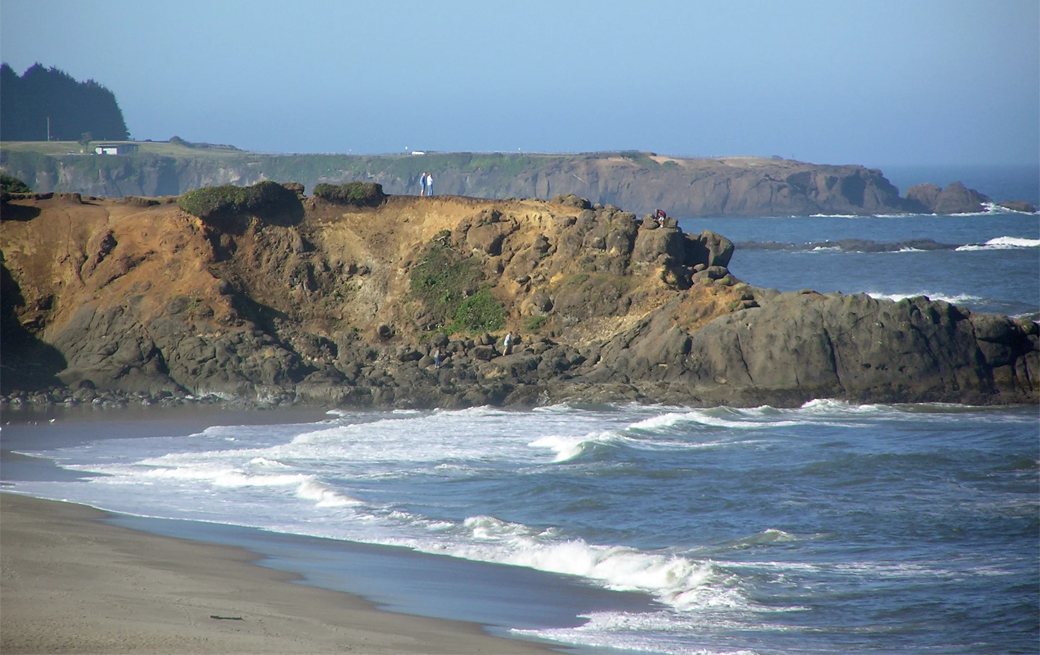
The eclipse will begin at Fishing Rock at approximately 9:04am PT with totality starting at about 10:15am PT and lasting for around one minute and 59 seconds.
2. Volcanoes EclipseFest — Keizer, Oregon
All around the U.S., minor league baseball teams are known for their goofy promotions and silly gimmicks. Even some of the team names are absurd: the El Paso Chihuahuas, the Lansing Lugnuts, the Montgomery Biscuits. But the Salem-Keizer Volcanoes have come up with one of the zaniest (and best!) minor league baseball promotions of all time.
The Volcanoes, a Class A affiliate of the San Francisco Giants, will host a three-game brewfest on August 18, 19, and 20. But that's not the best part. The celebration will culminate with a morning game on August 21 that will feature the first ever "eclipse delay" in baseball history. As the moment of totality approaches, the game will be paused, fans and players alike will don their Volcanoes-branded eclipse glasses, and everyone in the ballpark will witness the sight of a lifetime. After totality, the game will resume—no tarp roll-up necessary. If you're a baseball fan, how can you resist?
The eclipse will begin at Volcanoes Stadium at approximately 9:05am PT with totality starting at about 10:17am PT and lasting for around one minute and 49 seconds.
3. 1918 Viewing Site — Baker City, Oregon
Before 2017, the last time a total solar eclipse swept across the U.S. from coast to coast was 1918. That eclipse, too, entered the U.S. in the Pacific Northwest. There aren't too many places where the paths of both the 1918 and 2017 eclipses overlap before they diverge, but Baker City, Oregon, is one of them and that's where a U.S. Naval Observatory team stationed itself to observe the 1918 eclipse. Led by astronomer John C. Hammond, the team included eclipse expert Samuel Alfred Mitchell and artist Howard Russell Butler, whose painting of the eclipse was important in a day before reliable color photography.
According to an expedition report written by Hammond, "an ideal site was obtained at the fair grounds which were located about a mile from the center of the city." Maybe someone in Baker City can tell you if the original fairgrounds still exist. If so, and if you're an astronomy history buff and think this might be cool, maybe you can view the eclipse from that exact spot and follow in the footsteps of the men from 1918.
The eclipse will begin at downtown Baker City at approximately 9:09am PT with totality starting at about 10:24am PT and lasting for around one minute and 34 seconds.
4. Craters of the Moon National Monument — Butte County, Idaho
On May 2, 1924, President Calvin Coolidge signed a proclamation establishing Craters of the Moon National Monument. Today, it encompasses over 1,000 square miles of volcanic features and lava fields.
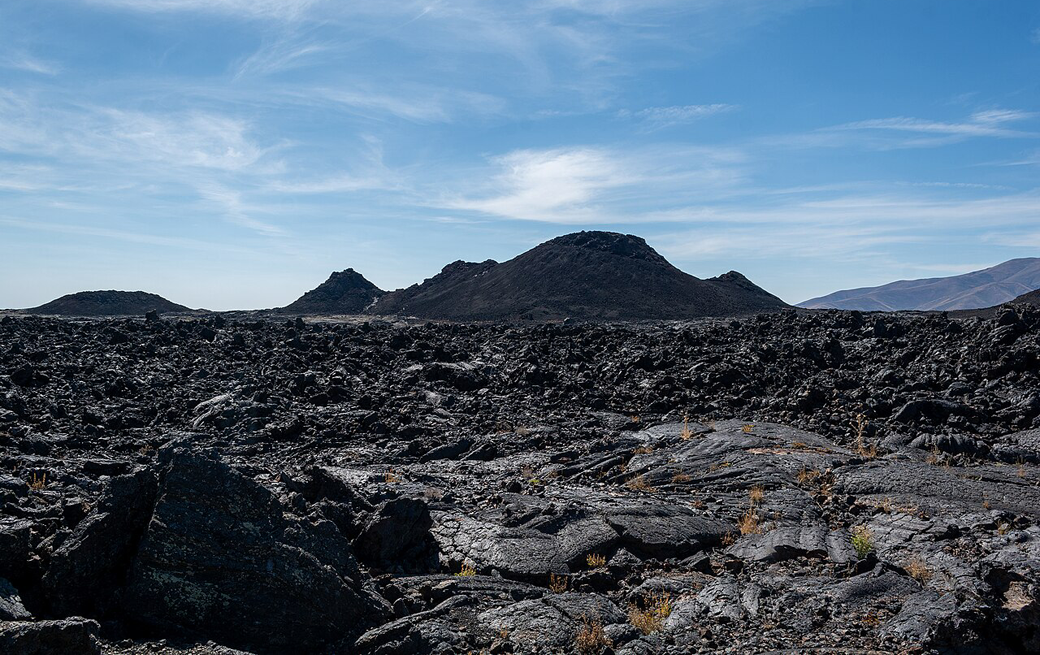
Certainly, there are lots of scenic places and stunning vistas along the path of totality, especially in the western U.S., from which you can view the 2017 eclipse. But where else can you bask in the shadow of the Moon in a place that purportedly looks like the Moon? Granted, most of Craters of the Moon National Monument lies outside the path of totality to the south. If you want to see a total eclipse, you'll need to find an access point in the very northern reaches of the preserve, just below the town of Arco, Idaho. And even then, you might only get a little more than a minute of totality. But the landscape will be otherworldly.
The eclipse will begin at the northern tip of Craters of the Moon National Monument at approximately 10:13am MT with totality starting at about 11:31am MT and lasting for around one minute and 16 seconds.
5. Carhenge — Alliance, Nebraska
If you'll be in western Nebraska on August 21, 2017, consider viewing the 2017 eclipse from Carhenge. It's one of several viewing sites designated by the city of Alliance and it's arguably one of the most unique along the path.
If you can imagine Stonehenge, but with automobiles instead of stone monoliths, that's Carhenge. Conceived by Jim Reinders in 1987 as a memorial to his father who lived on the site, it was constructed with 39 vintage American-made cars. The cars, painted gray to mirror Stonehenge, are arranged in a circle to closely replicate the prehistoric astronomical site in England. It may all be a bit kooky, but it's pure Americana right in the heartland...so maybe, it's the perfect place to view a total eclipse that will be visible only in America. Plus, it's virtually right on the centerline.
The eclipse will begin at Carhenge at approximately 10:27am MT with totality starting at about 11:49am MT and lasting for around two minutes and 29 seconds.
6. The Iowa Triangle — Fremont County, Iowa
If you've already done some research on where to view the 2017 eclipse, you've probably at least memorized the 12 states through which the path of totality will travel, from Oregon in the west to South Carolina in the east. If so, you're probably wondering Iowa? The eclipse doesn't travel through Iowa. But it does. As the path of totality exits Nebraska, the northern line of the path makes a short side trip into Fremont County, Iowa, before entering Missouri. The word "short" is really an overstatement here. It amounts to a distance of less than two miles and the resulting wedge of farmland—which we've dubbed the "Iowa Triangle"—is just shy of a mile square.
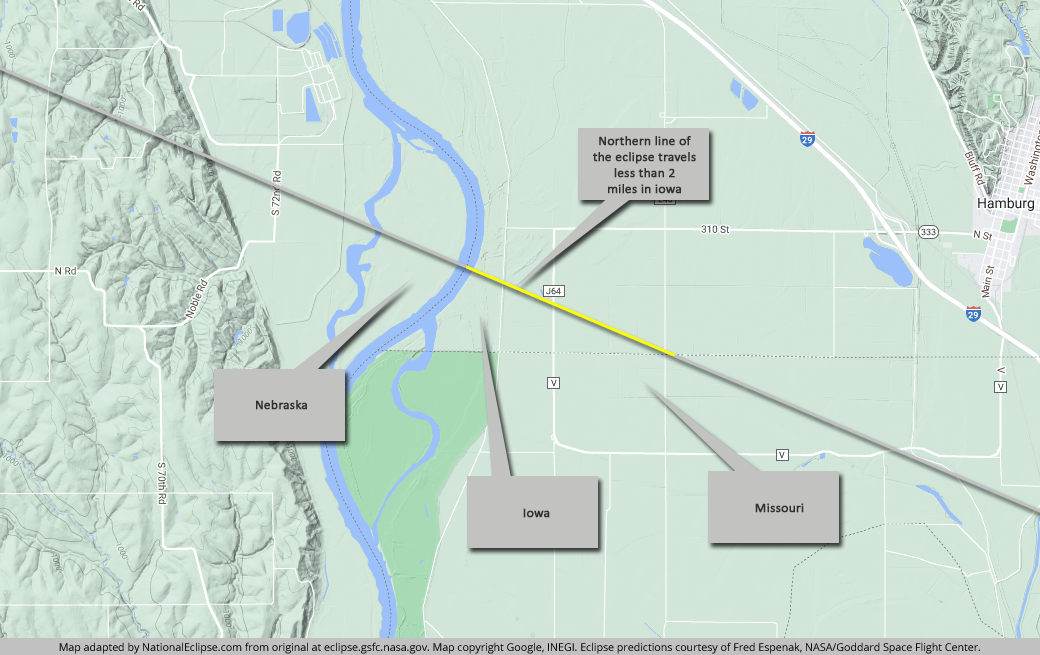
If you'd like to forever be known as the only person to have witnessed totality in Iowa on August 21, 2017, here's your chance (assuming nobody else shows up). There are exactly three roads that can be used to access the Iowa Triangle: 240th Avenue, County Road J64, and 100th Street, which forms the bottom side of the triangle as it runs along the Iowa-Missouri state line. Since this eclipse path anomaly occurs at the very northern limit of the path, totality here will be very, very short. But it will make for a good story and possibly a good claim to fame.
The eclipse will begin at the intersection of 100th Street and 240th Avenue at approximately 11:38am CT with totality starting at about 1:05pm CT and lasting for around 25 seconds.
7. Eclipse Crossroads — Jackson County, Illinois
After 2017, the next total solar eclipse to occur in the U.S. will take place on April 8, 2024. Since the 2017 eclipse crosses the country from northwest to southeast and the 2024 eclipse travels through the nation from southwest to northeast, the two paths cross each other and create a zone of overlapping totality in southeastern Missouri, southern Illinois, and western Kentucky. If you stand in the same place within this totality zone on August 21, 2017, and April 8, 2024, you can tell your friends that you witnessed two total eclipses from the same spot in seven years. Pretty neat, right?
This totality zone is big, encompassing roughly 9,000 square miles. But when two eclipse paths cross each other, there can only be one unique point on Earth where both centerlines meet. For the 2017 and 2024 eclipses, that point is located near the eastern shore of Cedar Lake in Jackson County, Illinois. Of course, if you set up camp in the nearby town of Makanda, less than four miles away, nobody will dispute your claim that you saw the eclipse from the crossroads. In fact, even the largest nearby city, Carbondale, is calling itself the "eclipse crossroads of America." What's more, the 2017/2024 centerline crossing is coincidentally located only about ten miles from the "point of greatest duration" in 2017. If you decide to view the eclipse at or near the crossroads on August 21, you'll also enjoy the longest total eclipse in the country.
The eclipse will begin at the centerline crossing at approximately 11:52am CT with totality starting at about 1:20pm CT and lasting for around two minutes and 40 seconds.
8. "Little Green Men" Days Festival — Kelly, Kentucky
Every year, the unincorporated community of Kelly, Kentucky, holds an event called the "Little Green Men" Days Festival. The festival commemorates a local encounter with supposed extraterrestrials, known as the Hopkinsville Goblins, that took place on August 21, 1955. Notice the date? The close encounter occurred on the exact date of the upcoming 2017 eclipse, 62 years before.
If the date connection isn't enough to raise the hairs on the back of your neck, the site of the farmhouse where the encounter occurred just happens to be mere miles from the exact spot on the eclipse path where the Moon's shadow aligns most closely with the Earth, called the "point of greatest eclipse." Coincidence? Or are the Hopkinsville Goblins coming back on August 21, 2017? Some think they are. If you attend the "Little Green Men" Days Festival, you might just find out.
The eclipse will begin at the "Little Green Men" Days Festival at approximately 11:56am CT with totality starting at about 1:24pm CT and lasting for around two minutes and 38 seconds.
9. Clingman's Dome — Swain County, North Carolina
At an elevation of 6,643 feet, Clingman's Dome is the third highest point in the eastern U.S. But since those other two peaks are outside the path of totality, that makes Clingman's Dome the place to be in the east if you want to be as high as possible on August 21, 2017. As far as eclipses go, being up high has its advantages. You might be able to see the shadow of the Moon racing toward you across the landscape at faster than the speed of sound. And, especially here in the Great Smoky Mountains, it gets you up above any trees that might block your view of the sky.
As luck would have it, Clingman's Dome is one of the most accessible mountains in the Great Smoky Mountains National Park. There's a neat-looking observation tower at the top of the mountain that, needless to say, will be a very popular place on eclipse day. The 45-foot high concrete tower only has a 28-foot diameter platform, so space is definitely limited. Perhaps the National Park Service will make passes available via a lottery system. If not, you'll need to show up really early.
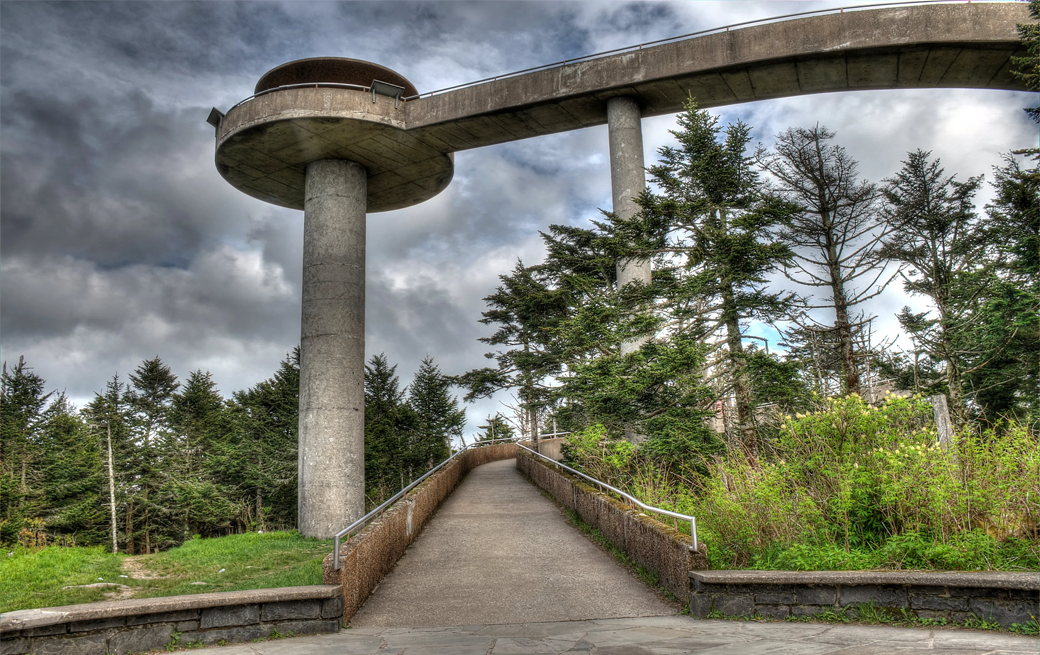
The eclipse will begin at Clingman's Dome at approximately 1:06pm ET with totality starting at about 2:35pm ET and lasting for around one minute and 24 seconds.
Update: Indeed, the National Park Service has made Clingman's Dome a ticketed event site. As of April 2017, tickets are no longer available.
10. Cape Romain National Wildlife Refuge — Charleston County, South Carolina
Stretching along 22 miles of coastline and consisting of 66,000 acres of salt marshes, maritime forest, and coastal waterways, Cape Romain National Wildlife Refuge is where the centerline of the 2017 eclipse will last touch U.S. soil. Most of the refuge is either not on solid ground or only accessible by water, which offers a convenient excuse to view the eclipse by boat if you'd like to be one of the very last people in the U.S. to wave goodbye to the shadow of the Moon as it heads out into the Atlantic Ocean before concluding its journey off the coast of Africa.
A couple of small fishing towns, like Awendaw and McClellanville, are located on the mainland adjacent to the refuge. You can bet that enterprising boat owners will be renting and chartering vessels of all types and sizes on August 21. For past eclipses, especially those that have occurred mainly over open ocean, entire cruises have been organized for the benefit of eclipse chasers. Maybe a few ship captains will offer something similar. But whatever your vessel of choice—from rowboat to cruise ship—and wherever you happen to be—a few feet from the refuge or miles out at sea—being on the water as the 2017 eclipse exits the U.S. will unquestionably qualify as a unique eclipse experience.
The eclipse will begin at the eastern end of Cape Romain National Wildlife Refuge at approximately 1:18pm ET with totality starting at about 2:46pm ET and lasting for around two minutes and 34 seconds.
In Conclusion
We're not claiming that any of these viewing sites are the "best" or "greatest" places to view the 2017 eclipse. They may not necessarily have the most promising weather prospects or the longest durations of totality and some of them may be far off the beaten track. If you've never seen a total solar eclipse before, you may want to hedge your bet by selecting a site located close to the centerline in an area that offers a good possibility of favorable weather. On the other hand, if you're a nonconformist who enjoys a good adventure, consider viewing the 2017 eclipse from one of these ten unique places. And even if you don't, simply knowing about them is fun too.